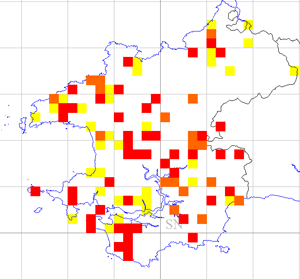Barn Owl - 2003-07
 Wednesday, May 9, 2012 at 6:22PM
Wednesday, May 9, 2012 at 6:22PM Barn Owls are thinly scattered across the county, mainly associated with farmland, particularly where there are good amounts of rough grazing. River valleys, such as those of the Western and Eastern Cleddau, are good areas for them. They mainly nest in farm buildings, including crevices in natural cliffs and quarries. Old semi-ruined buildings can also be important. Being a Schedule 1 species (under the Wildlife and Countryside Act) they are afforded extra protection measures, such locations need to be considered carefully in development planning applications.
They will readily utilise artificial nest sites provided in appropriate locations, including nest boxes placed in modern farm buildings or in trees. Being mainly nocturnal, Barn Owls can be difficult to locate. However, breeding adults can often be seen out hunting before dark when they are feeding young, gracefully flitting along hedgerows and grassy areas in search of rodents.
Due to recording difficulties, the atlas tetrad maps probably under-estimate their true distribution. Nevertheless, the number of tetrads in which they were recorded was actually very similar in both atlas periods.
With annual fluctuations in breeding success, mainly linked to cycles in vole populations, it is very difficult to estimate Barn Owl population levels without detailed study. It was considered that there were around 100 breeding pairs in Pembrokeshire in 1984-88, based on the number of tetrads where they were found.
During the first atlas survey a large proportion of the records of Barn Owls came by talking to farmers, something that was also important during 2003-07.
With an absence of more detailed methods of estimating the population, the overall population is considered to be similar to that of the earlier period. The total number of tetrads with confirmed and probable breeding was higher than that of the earlier atlas period, so the actual breeding population may have been higher.
Since the 1980s, winters have been generally milder so winter survival of Barn Owls may also have improved. More detailed surveys are needed to refine ways of estimating population levels.
Bob Haycock

Fieldwork 2003-07 (based on 490 tetrads)
Red = breeding confirmed = 47
Orange = breeding probable = 18
Yellow = breeding possible = 36
Total tetrads in which registered = 101 (20.6%)
 PBBA 2003-7,
PBBA 2003-7,  RJH in
RJH in  Barn Owl
Barn Owl 

Reader Comments